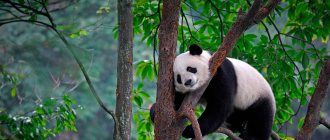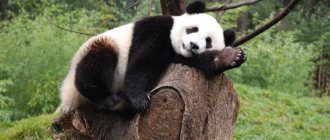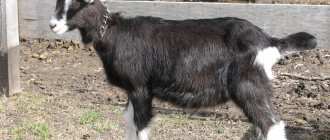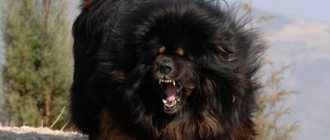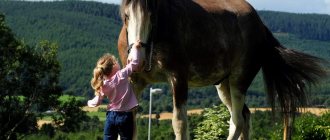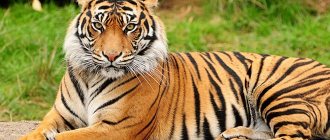The decision to organize a large reserve is due to the fact that the giant panda is under threat due to poaching and climate change. The Chinese government has invested heavily in the population of these bears, which number less than 3,000 in the wild.
- Endangered animals on the planet
- The strangest animals in the world
- Emperor penguin and his hard life
In recent years, the Panda has become a symbol of wildlife conservation around the world, as well as other wild animals in China. This country is taking unprecedented measures to preserve this species, including establishing a huge reserve for giant pandas.
Social structure and reproduction
Photo: Great white panda
Pandas are known to be very caring, patient and loving parents. Animals tend to form a pair only for the period of marital relations. This period is seasonal and begins with the first days of spring. Each mature female can bear offspring twice a year and give birth to 1-2 cubs. The period when mating can lead to fertilization lasts only three to four days.
Interesting fact: After mating, embryo development does not begin immediately. From the moment of mating to the start of embryo development, it can take from one to 3-4 months! In this way, nature protects the cubs by selecting more favorable climatic conditions for their birth.
The gestation period lasts about five months. Babies are born completely helpless - they cannot see anything, they have practically no hair. Bear cubs are born very small. The weight of one baby barely reaches 150 grams. The cubs are completely unadapted to life in the environment and are entirely dependent on their mother. The mother bear, no matter what she does, remains close to her cub all the time. Newborns feed heavily in the first months of life. The number of feedings reaches 15 times a day. After just two months, the cubs weigh four kilograms, and by six months they gain as much as ten.
At about a month, the cubs begin to see and gradually become covered with fur. When they reach three months of age, they begin to walk. Babies begin to move independently and explore space only at one year of age. They feed on mother's milk for the same amount of time. They need about another 6-8 months to adapt to the environment. After this, they begin an isolated lifestyle.
If a female gives birth to two cubs, most often she chooses the stronger and more viable one and begins to care for and feed him. The fate of the weakest is starvation. When breeding in captivity, people most often separate the rejected cub and periodically swap it with a stronger cub until it becomes independent.
The period of puberty in black and white bears occurs when they reach 5-7 years. The average lifespan of bamboo bears in natural conditions is 15-17 years. In captivity they can live almost twice as long.
Description of the animal
The red panda looks very cute and seems like a friendly, harmless animal. Especially if you see an animal sleeping on a branch with its belly down, its short legs hanging down. The red panda is a predator with tenacious claws and sharp teeth, bravely defending its territory and ready to stand up for itself.
What does it look like
The red panda is a medium-sized animal that resembles a cat, a bear cub, and a raccoon. Body length is about 50-60 centimeters. The animal weighs from 3 to 6.5 kilograms. Usually such a mass occurs in domestic cats, especially if they are fed a little more than necessary.
The animal has a very fluffy tail. Its length differs in different individuals, it can be either 30 centimeters or 50.
The beautiful tail is another proof that the red panda does not belong to the bear family. Its representatives usually have small tails.
The head of the animal is wide, and the muzzle itself is pointed. The eyes are small, like tiny buttons peeking out of thick fur.
The forehead is high, which makes the muzzle seem even more cute and funny. Around the eyes you can see a mask, by which raccoons are usually recognized. Different representatives of the species have different muzzle colors. There are no identical masks.
The red panda's fur is soft, thick and long. Because of this, the animal appears larger and thicker than it actually is:
- on top, six are bright brown, nut-colored;
- darker or even black below;
- on the back the hairs are distinguished by yellow tips.
The animal's tail is red, with yellowish rings visible on it. They are lighter than the fur nearby, which makes the tail appear fuller. The muzzle, with the exception of the dark nose, is white, as are the semicircular ears at the edges. On the outside they are brown, even reddish.
The animal's paws are short and covered with black hair. It is also on the feet, which helps to quickly move on slippery surfaces, such as ice. The panda has strongly curved, semi-retractable claws.
Thanks to this, she deftly climbs trees, clinging to branches and trunk. By the way, her tail helps her maintain balance. Do not forget that the animal spends most of its life in trees, and it is extremely necessary for it to balance.
Systematics and evolution
Despite the name, the small furry animal is not a close relative of the Giant Panda, the well-known bamboo bear, the symbol of China. Yes, animals have a common ancestor, but he lived several million years ago.
The giant and small panda even belong to different families. For a long time, the red panda could not find a place in the international classification of animals.
So the animal with beautiful fur belongs to the Panda family. It was believed that it has one species and a single genus - the Lesser Panda, and before there were other animals that are now considered extinct.
Based on the results of recent research, scientists have concluded that there are two types of animals, Chinese and Himalayan pandas. The latter have different muzzles, they are lighter.
Once upon a time, the red panda, like the big one, belonged to the bear family. However, the animal has characteristics that make it possible to classify it as a canine, a raccoon, and even a mustelid.
Scientists suggest that the distant ancestor of the red panda could have lived back in the Miocene era. This is a period that began 23 million years ago and ended 5 million. Previously, the habitat of animals was much wider than it is now. Animals could be found in many areas of the Eurasian continent.
Thus, the fossil remains of the red panda were discovered by researchers even in the UK. Traces of its existence have also been noticed in North America. Perhaps an unknown subspecies was found there, the representatives of which did not survive to our time.
Character and lifestyle
The furry animal prefers to rest in the light of the sun. And when dusk comes, the animal gets out of its hiding place and descends to the ground. It is here that he looks for food, despite the fact that he spends most of his life in the trees.
Pandas usually live alone. Females allow males to approach them only during mating, which happens once a year. The rest of the time, animals guard their habitat and protect it:
- the female usually has enough space up to 2.5;
- males need a territory at least twice as large.
If someone approaches an inhabited area, pandas hiss, quite ferociously, frighteningly, and warn that they are ready to stand up for their home. When the opponent refuses to leave, the animals begin to fight. It is based on its results that it will be clear who will have to leave the area.
In order to mark their territory, and also tell about themselves, their age, and condition, pandas leave scent marks using:
- Urine;
- The secret of the paraanal glands. Also, such aromatic or olfactory glands are found on the soles of the paws of furry animals.
Although red pandas are solitary, you can sometimes see them moving in pairs and living in small groups. And this happens because the cubs remain dependent for a long time. It is believed that they live next to their mother for the entire year after birth, or even longer. They spend all this time together in the territory protected by the female.
What does it eat?
The red panda is a predator. Although the bulk of her diet is plant foods. Although the structure of the internal organs, namely the intestines, is not suitable for digesting such food.
A panda will almost never refuse bamboo. However, it is absorbed, providing the animal with nutrients and beneficial substances, by less than a third. Moreover, the fluffy animal also chooses what is suitable for food and what is not. So, he will prefer fresh, juicy shoots.
He likes the tender parts of the plant. This is one of the differences from the Giant Panda, who will never choose bamboo or neglect it. The black and white bear welcomes him in any form.
In addition to bamboo, the diet of the animal with bright fur includes:
- berries;
- mushrooms;
- bird eggs;
- fruit;
- flowers;
- small animals;
- small birds.
Zoo residents are given fruits, sometimes vegetables, even cookies, but not ordinary ones. They are made specifically for small creatures using bamboo fiber.
Where does it live?
In the wild, the red panda, also called the fire panda, lives in the southeastern part of the Himalayas. The animal is found in the forests of China and India. Several hundred individuals have been recorded in Nepal.
Animals choose terrain at an altitude of two to four thousand kilometers above sea level. Mixed forests suit them. Fluffy pandas live among fir, maple, and oak trees, which protect bamboo and help it develop.
Their distribution area has noticeably decreased over time. Scientists attribute this to the environmental situation, as well as climate change.
Reproduction
Small pandas bear offspring once a year. The mating season usually begins with the arrival of January. After fertilization, the cubs can appear in either three or five months. The most interesting thing is that they do not develop throughout this entire period. They need about 50 days.
At some point, growth and development stop, but this does not affect the health of the animals in any way. Just a short pause. Perhaps this only happens in captivity. In the natural environment, it is not possible to observe the pregnancy progress of wild animals.
Several babies are born. Usually 2-4 babies are born, and of these few offspring only one remains alive.
Only he manages to reach the age of puberty. And it begins in fiery furry animals by 18 months. However, red pandas are considered adults only when they reach 2-3 years of age.
Newborn babies are very helpless. They don't see or hear. The mother takes care of them and at first almost never leaves the nest. She prepares it, feeling the approach of labor. The choice stops on rocks, discovering crevices, or hollows. For construction, the female uses branches and foliage.
Cubs at birth weigh only 100 grams. They grow and develop very slowly. Their eyes open after about three weeks. And all this time, the mother tirelessly returns to her offspring several times a day:
- cleans the nest;
- washes children by licking them;
- feeds them.
Babies will continue to eat mother's milk for a long time; they usually give it up by the age of five months, gradually starting to move on to solid food. They meet her 3-4 months after birth.
Then they just begin to crawl out of the nest, but they don’t go far from their mother, they stay close and accompany her everywhere. It happens that separation, and therefore resettlement, occurs only at the moment when the female is again ready to continue the race.
By this point, children are already growing up, becoming independent, and sometimes even aggressive. An excellent time to search for your own territory for further residence and reproduction.
Pandas live on average 9-10 years. In captivity, with good maintenance, life expectancy increases significantly. Thus, there is a known case when a panda in a zoo died at the age of 18.
Natural enemies
There are not very many enemies that truly threaten the lives of furry animals in the wild. The fact that animals usually live in trees significantly reduces the number of those who pose a danger to them.
Natural enemies of red pandas include:
- Red wolves. They are also called Himalayan. Outwardly, they resemble a fox, a wolf, and have the features of a jackal. Predators usually live in packs and also hunt in groups. It happens that a pack consists of several dozen red wolves;
- Snow leopards , also known as snow leopards . These are wild cats, very similar to leopards, but more compact. The leopard is somewhat larger and more graceful. The snow leopard prefers to hunt alone. Usually it lies in wait for prey near water bodies, attacking ungulates, but it can also cope with a bear.
But red wolves and snow leopards are on the verge of extinction. Their populations are rapidly declining. The number of animals is so small that the likelihood of them attacking a red panda is very low.
Why are giant pandas no longer an endangered species?
The giant panda population has remained low for more than a thousand years. Although there is no data on how many animals lived in China in ancient times (recall that the giant panda is a Chinese endemic), medieval chronicles say that they were considered a rarity even then. In any case, in the 6th-7th centuries these animals were mentioned as a valuable diplomatic gift, which they remained until the middle of the 20th century.
The bamboo bear was truly a royal gift in ancient times.
In the 80s of the last century, giant pandas, being a symbol of China, became so scarce that the government of this country took unprecedented measures to save them. In particular, special centers for the study and breeding of pandas were created, among which the most famous is the reserve and nursery in Chengdu. At the same time, a strict ban on hunting and trapping these animals was introduced, violation of which is punishable by death. The sale of giant panda skins and other parts of its body is also severely punished. In parallel, the government has invested heavily in preserving the habitat of giant pandas.
It took a huge effort to stop the destruction of giant pandas.
All these measures had a positive effect, and after a census of giant pandas conducted in 2016, it was found that the population size had increased significantly. This achievement made it possible to change the status of the bamboo bear in the Red Book from endangered to vulnerable. According to optimistic zoologists, further work in this direction will increase the number of these animals by another 30% over the next two to three decades.
The growth of the giant panda population is a source of national pride for China.
Nutrition
Giant pandas prefer a vegetarian diet. Despite being a predator, the basis of their diet consists of plant foods. Typically, the biggest delicacy associated with the life of this cute beast is bamboo stalks.
They eat it in incredible quantities. One panda accounts for as much as 30 kilograms of bamboo. In the absence of bamboo, large bears do not mind gorging themselves on other plants or fruits. Sometimes a panda can be caught eating insects, fish and other small mammals.
Small red panda in the Red Book
There are only a few thousand red pandas left in the world, including those living in zoos and nature reserves. Scientists face a serious challenge - to understand how to act to preserve the animal population. To begin with, the animal was included in the International Red Book as a representative of an endangered species.
Main causes of extinction
The main factor contributing to the decline in animal numbers is the disappearance of forests. Man is occupying ever larger areas, destroying natural plantings, harvesting wood or freeing up areas for construction. Bamboo, which is one of the products that makes up the predator’s diet, also disappears.
In addition, people hunt animals. Poachers want to get to the beautiful fur of the animals, the hats from which are in demand. In areas where pandas live, people set traps. Even if their goal was not to destroy the red animal, they suffer and die when they fall into traps.
Current population situation
Currently, red pandas are on the verge of extinction. The animal population numbers about 2.5 thousand individuals. According to other sources, up to 5 thousand red pandas live in the wild.
More than 300 representatives of the panda family live in zoos around the world. Animals quickly adapt to captivity and reproduce well. That is why scientists are not so worried that the animals will disappear from the face of the earth. However, the species continues to be considered endangered, which confirms its conservation status.
What measures were taken to protect
Distant relatives of black and white bears are protected and listed in the Red Book. Hunting for them is prohibited, but poachers continue to exterminate rare animals for valuable fur. However, if the violation of the law is proven, the person will face punishment.
Given that scientists have discovered two species of red pandas, measures must be taken to prevent them from interbreeding. This, along with diseases and a difficult environmental situation, can pose a danger to animals.
In June 2022, scientists began conducting research, the results of which should help protect the population. Animals living in captivity are monitored using drones.
Experts hope in this way to obtain information about what poses a threat to the life of red pandas. By understanding the main reasons for their extinction, you can stop this process and understand what measures to take to protect the animals.
The “Save Rare Species” program – how can you help?
In 2013, the “Save Rare Species” program was launched. The goal of the program is to raise funds for projects to preserve rare species of animals in Russia. In gratitude, each participant in the program receives from WWF a kit with a stuffed animal - a symbol of a good deed and participation in important environmental projects.
Thanks to the program participants, a lot has already been done:
- In winter in Primorye, feeding of large mammals hunted by Amur tigers and Far Eastern leopards was carried out
- Operation “Spring Trail – 2014” started in the Arctic to count the polar bear population
- New camera traps have been installed in the habitats of Far Eastern leopards
Join the “Save Rare Species” program today, in the anniversary year of the 20th anniversary of WWF’s work in Russia. After all, only by joining our efforts will we be able to continue working to preserve the amazing and fragile nature of our country!
Behavior
Unlike many other bears, giant pandas do not hibernate. But they descend to lower altitudes during the winter. Giant pandas do not build permanent burrows, but rather take refuge in trees and caves. They are primarily terrestrial animals, but are also good climbers and swimmers. Giant pandas are mostly solitary except during breeding season. Panda mothers play with their cubs, not only to soothe the babies, but also for fun. Some mothers often wake up their cubs to play with them.
“Thumb” (a structural feature of the paw)
Particularly noteworthy is the distinctive feature of pandas, which distinguishes these animals from other varieties of bears even more than their unusual appearance. Giant pandas have unusual front feet, with a "thumb" and five normal toes. On the soles and at the base of each toe, bare pads are well developed, making it easier to hold the smooth bamboo stems. The panda's famous "thumb" is actually a modified sesamoid bone of the wrist. Sesamoid bones are bones that are located within the thickness of tendons and usually lie on the surface of other bones.
Thanks to this unique “finger,” the panda can easily handle even the thinnest bamboo shoots, grab branches, and perform a number of other actions that are inaccessible to other types of bears. Captive pandas can use their front paws to hold balls and enamel and aluminum bowls while waiting to be filled with food. The “grasping” structure of the forelimb allows even massive adult pandas to climb to the very top of trees. Climbing abilities are used by these amazing animals for a variety of purposes - in this way they navigate the terrain, escape from danger, taste young shoots, or simply have fun. Sometimes they climb up to rest.

